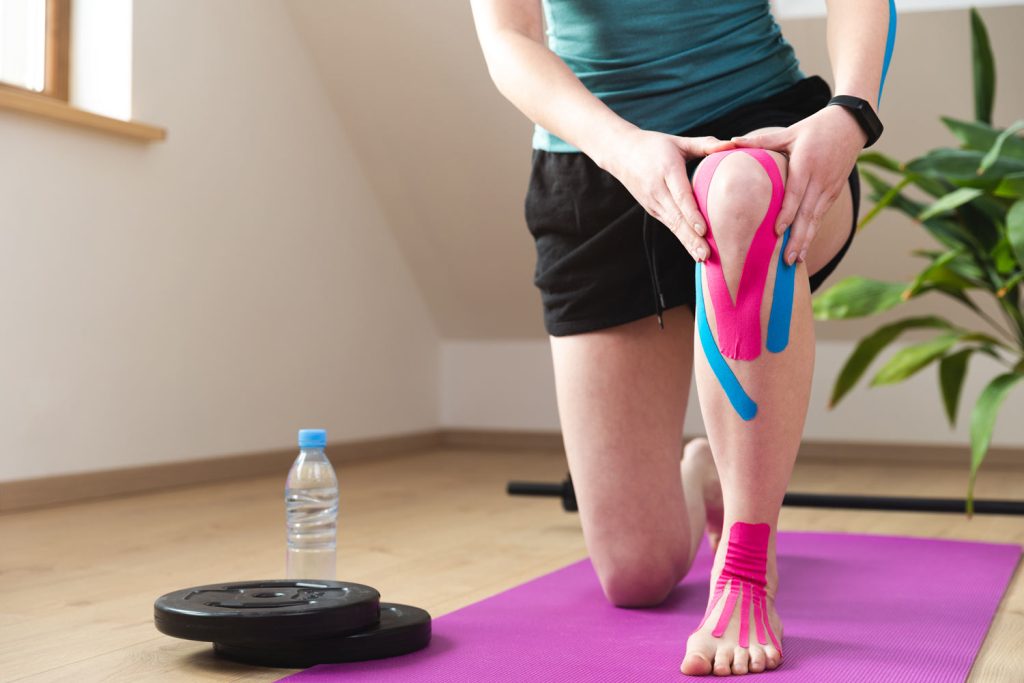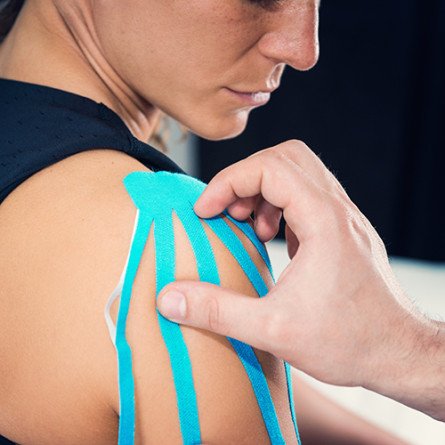What Are the Differences Between Athletic Tape and Kinesiology Tape?
What is an athletic tape? Well it is typically made from a thick, non-elastic cotton fabric that provides strong support and stabilization. In contrast, kinesiology tape consists of a thin, highly elasticized material that can stretch up to 140% of its original length, closely mimicking the skin’s elasticity.
Athletic tape features an adhesive designed for short-term use, often for a specific activity or event, providing a rigid hold that restricts movement. However, kinesiology tape uses a medical-grade, heat-activated adhesive that you can wear for several days, even through sweating and showering, making it more suitable for continuous therapeutic use.
How Does Athletic Tape Work Compared to Kinesiology Tape?
Athletes apply athletic tape to restrict movement and stabilize the affected area, providing support and reducing strain on muscles and joints during high-impact activities.
In contrast, kinesiology tape works based on the principle of proprioception—enhancing the sensory feedback within the body. When applied, it gently lifts the skin, creating a subdermal space that increases lymphatic drainage and improves blood flow. This not only reduces swelling but also alleviates pain by decreasing pressure on pain receptors.
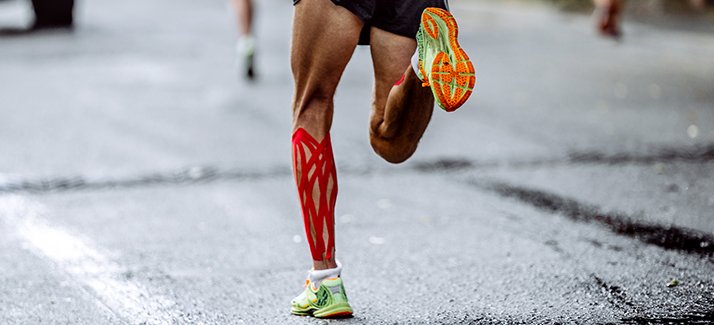
Due its mechanism, kinesiology tapes are widely adopted in long-distance running like .
Which Tape Is Better for Injury Prevention: Athletic or Kinesiology?
Can Athletic Tape Prevent Injuries?
Athletic tape is highly regarded for preventing acute sports injuries, especially in activities that involve a lot of physical contact or rapid directional changes. By immobilizing the joint or muscle, it reduces the range of risky movements that can lead to sprains or strains. This preventive approach is particularly effective in sports like football or basketball, where dynamic and sudden movements are frequent. During those sports, athletes use athletic tape to prevent sprains and other acute injuries by stabilizing joints like ankles,
Can Kinesiology Tape Prevent Injuries?
Kinesiology tape helps athletes maintain better control over their movements, potentially preventing overextension or improper alignment. Additionally, the slight lifting of the skin helps improve circulation and reduce inflammation, which are key factors in preventing overuse injuries.
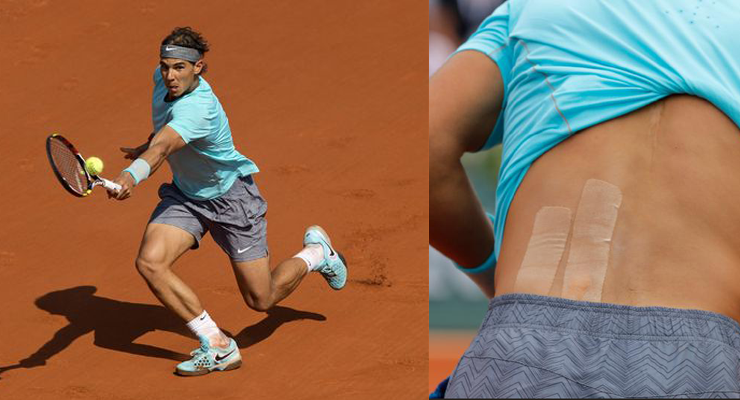
Tennis player Rafael Nadal, who suffers from injuries in hip and lower back, using kinesiology tape during a contest.
What Are the Pros and Cons of Athletic Tape Versus Kinesiology Tape?
Pros of Athletic Tape
- Strong Support: Athletic tape provides robust mechanical support, making it ideal for stabilizing joints during high-impact sports.
- Injury Prevention: It is effective in preventing acute injuries by limiting potentially harmful ranges of motion.
- Cost-Effective: Generally, athletic tape is less expensive compared to kinesiology tape, making it a budget-friendly option for many athletes and teams.
Cons of Athletic Tape
- Limited Wear Time: Due to its restrictive nature, athletic tape is often only worn during sports activities and must be removed afterwards to prevent skin irritation or reduced circulation.
- Less Versatility: It does not offer the therapeutic benefits of increased circulation and pain relief that kinesiology tape does.
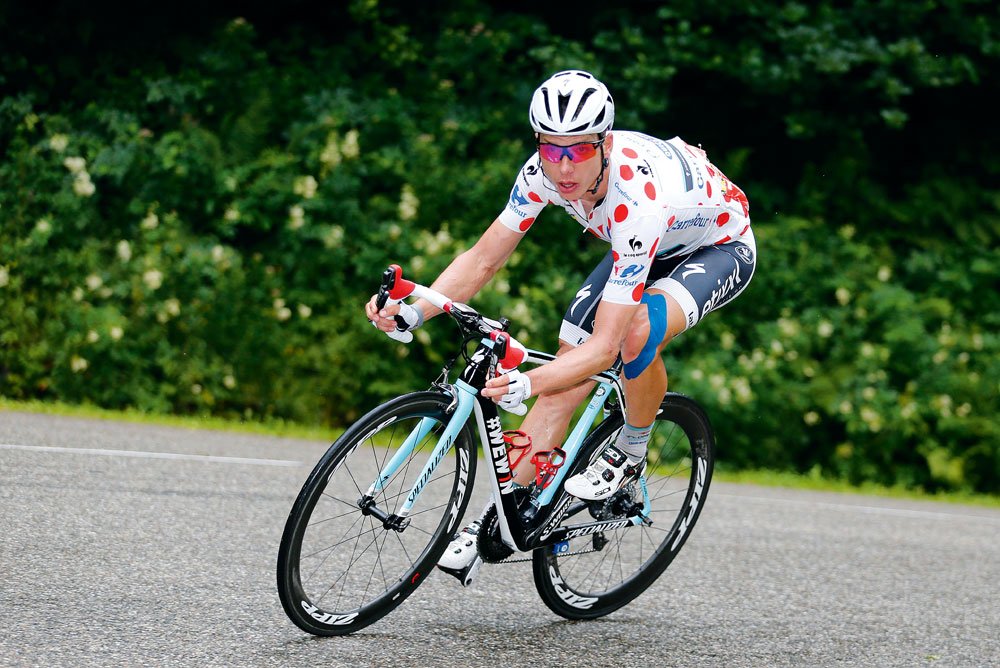
Pros of Kinesiology Tape
- Therapeutic Benefits: Kinesiology tape not only supports but also helps in pain relief and reducing inflammation due to its unique elastic properties that lift the skin to enhance blood flow.
- Longer Duration: It can be worn for several days at a time, providing continuous benefits without the need for frequent reapplication.
- Greater Flexibility: Its elasticity allows for a full range of motion, supporting muscles without restricting movement.
Cons of Kinesiology Tape
- Higher Cost: Kinesiology tape is generally more expensive than traditional athletic tape.
- Requires Precise Application: To achieve its therapeutic benefits, kinesiology tape must be applied with specific techniques, which may require professional guidance.
Which Type of Tape Is More Suitable for Chronic Injuries?
Kinesiology tape has sustained therapeutic benefits, such as improved circulation and pain relief, which are more useful to the rehabilitation of chronic conditions. Moreover, the fact that kinesiology tape supports the affected area without limiting mobility, promoting healing while maintaining functionality. This is particularly beneficial for injuries such as tendonitis, chronic muscle strain, or repetitive stress injuries.
Athletic tape, however, is limited when dealing with chronic injuries due to the restrictive nature and potential discomfort from prolonged wear.

Athletic tape appears when people need to prevent acute injuries, not treating chronic injuries.
Scientific Perspective
Studies, including those published in National Center for Biotechnology Information journals, suggest that kinesiology tape can reduce chronic pain and improve the range of motion over extended periods. Its application helps facilitate natural healing processes by subtly lifting the skin to increase blood flow and reduce pressure on underlying tissues.

Here is an example of waterproof and breathable kinesology tape.
When to Use Athletic Tape or Kinesiology Tape?
Kinesiology tape is best suited for situations requiring long-term support and therapy. It can be worn for several days, making it ideal for aiding recovery from chronic injuries. This tape is particularly effective in endurance sports such as running, cycling, or swimming, as it reduces muscle fatigue and improves endurance. Additionally, kinesiology tape provides pain relief and supports mobility by offering proprioceptive feedback without restricting the range of motion.
Athletic tape, on the other hand, is most effective for immediate stabilization and preventing acute injuries. It is widely used during high-impact or high-risk activities like basketball, football, or gymnastics to limit excessive movement and reduce the likelihood of sprains and strains. It is also a cost-effective option for individuals and teams seeking short-term support without the additional therapeutic benefits provided by kinesiology tape.
Conclusion
In conclusion, the choice between athletic tape and kinesiology tape ultimately depends on the specific needs of the athlete, the demands of the sport, and personal preference. Both types of tape offer unique benefits that can enhance performance, prevent injuries, and aid in recovery. Understanding the differences and applications of each can empower athletes to make informed decisions that best support their athletic endeavors.
At Fonitaniya, we are proud to offer both high-quality athletic tape and versatile kinesiology tape, catering to a diverse range of sports and activities. With years of experience in the adhesive products industry, we have developed a deep understanding of the unique challenges faced by athletes across various disciplines. Our products are designed to meet these challenges, providing reliable support, enhanced performance, and superior comfort.
Our history of innovation and commitment to quality has made us a trusted name in the world of sports adhesives. Whether you are a professional athlete seeking peak performance or an amateur looking to stay active and injury-free, Fonitaniya has the right tape to support your goals. Our extensive range of adhesive solutions ensures that we can cater to individual preferences and needs, making us a one-stop-shop for all your athletic taping requirements.
Visit our website to explore our full lineup of athletic and kinesiology tapes and discover how Fonitaniya can help elevate your performance and safeguard your journey toward achieving and exceeding your athletic potential. Let us stick by your side as you push the limits of what’s possible in your sport.
FAQs
What is the main difference between kinesiology tape and athletic tape?
Kinesiology tape stretches and supports without restricting movement, while athletic tape provides rigid support to stabilize joints.
How long can I wear kinesiology tape compared to athletic tape?
You can wear kinesiology tape for several days, usually up to 3-5, whereas athletic tape is best for short-term use during activities.
Can I wear athletic tape during everyday activities?
Athletic tape is generally best suited for specific sports activities and should be removed after use to avoid skin irritation.
Does kinesiology tape help with swelling?
Yes, it lifts the skin to increase blood flow and reduce swelling by improving lymphatic drainage.
Is athletic tape suitable for injury recovery?
Yes, it stabilizes the injured area, helping prevent further injury during recovery.
Does athletic tape reduce pain?
Yes, by stabilizing the affected area, athletic tape can help reduce pain associated with movement.
Why do athletes wear kinesiology tape?
Athletes wear kinesiology tape to support muscles and joints, enhance performance, and aid in the recovery from fatigue and injury.
Can athletic tape be reused?
No, once removed, athletic tape loses its adhesive quality and should be discarded.

